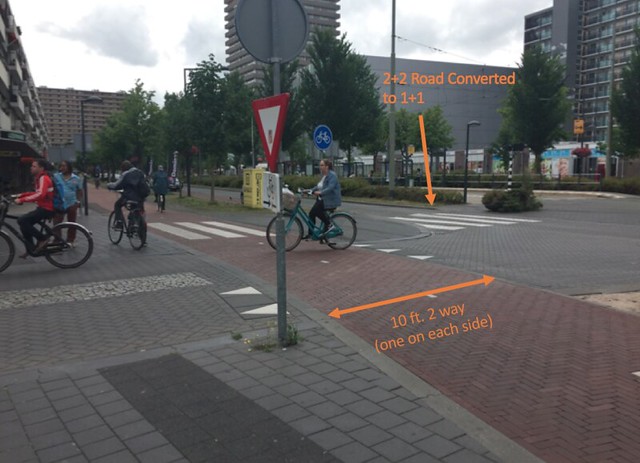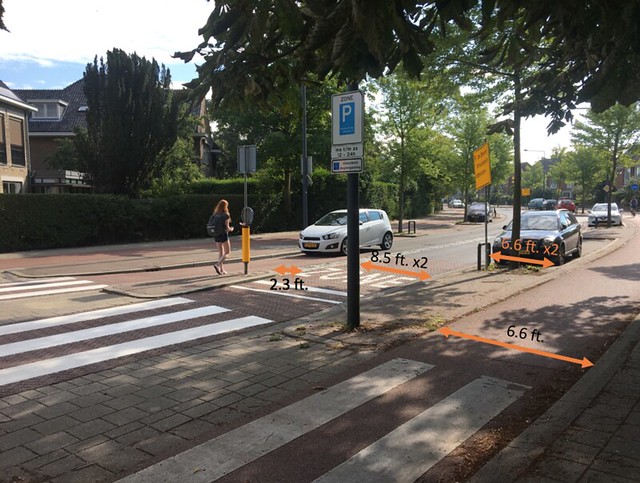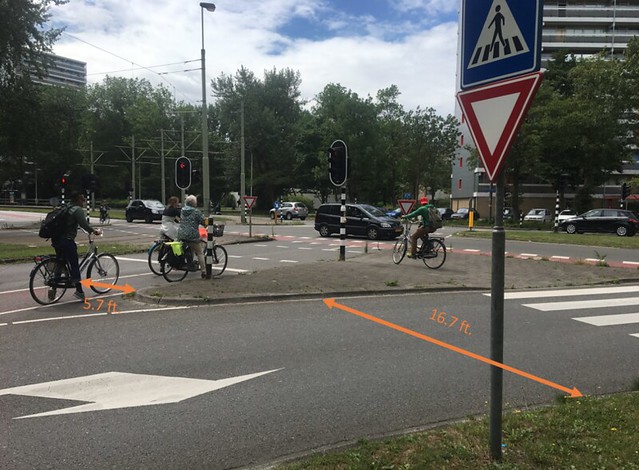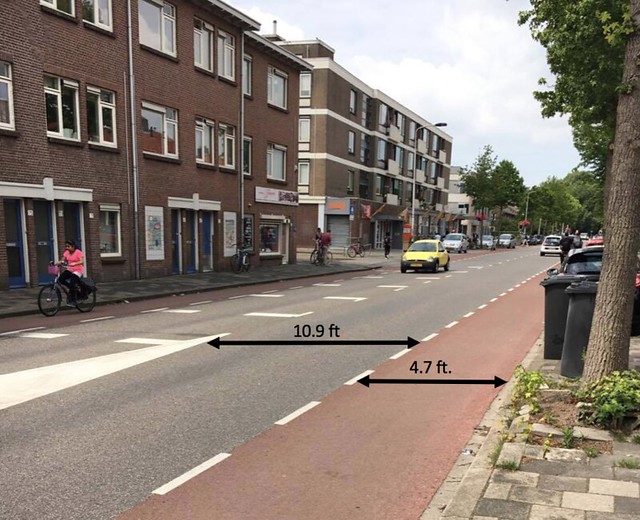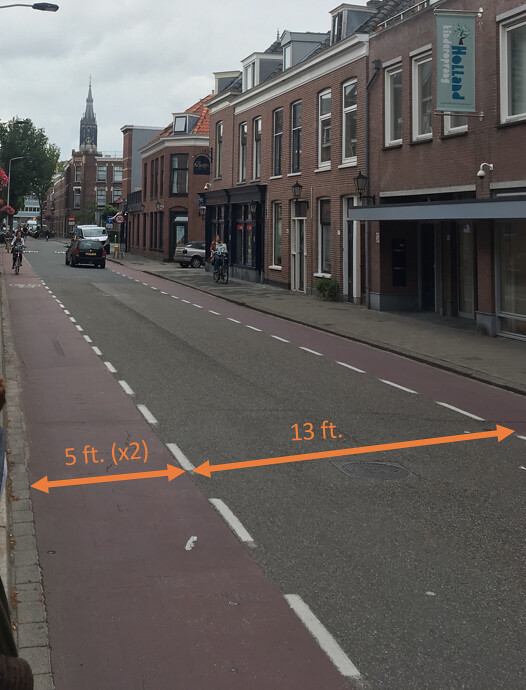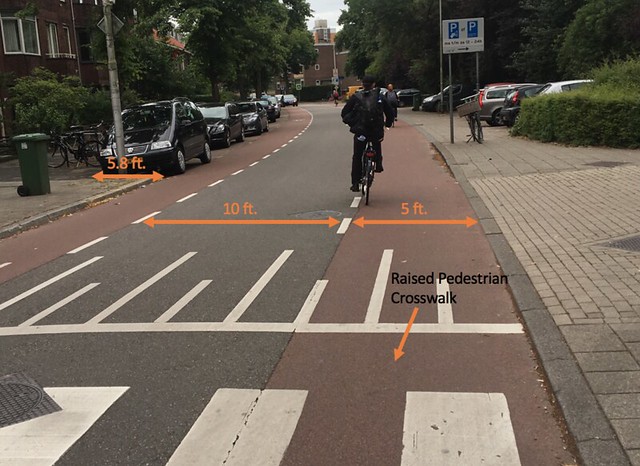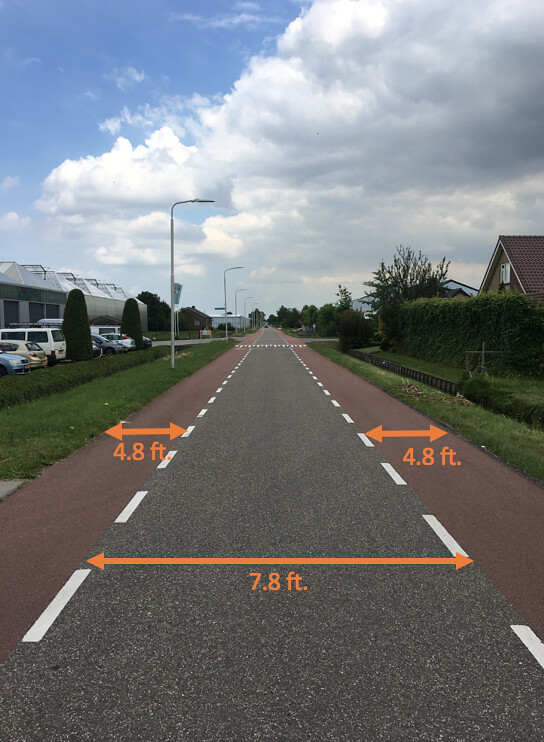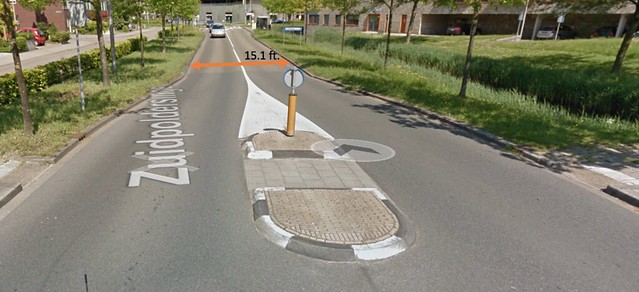HW4 Delft Jackson Lynch
Bike Boulevard
Bike boulevards often attempt to solve the problem of mixing heavy bike traffic and heavy car traffic on main travel roads. In order to accomplish this, bike-oriented routes are created on quiet roads parallel to busier roads while discouraging (and sometimes eliminating) through traffic of cars. Bike boulevards, or quiet ways, can achieve catering to biking along with discouragement to cars through several means including speed control, permeable barriers that allow bikes but not cars, and median diverters that cars can go through.
Site 1
In order to cross over the canal directly west of TU Delft, there are a few ways to go. Two main roads, Zuidwal and Kruisweg, both traverse it but are very car-centric, busy roads and are not great for bicycles. In order to create a sound environment for bikes to cross the canal, a bridge was built that only allows bicycles. On one side of the bridge (ahead of the picture), the boulevard turns into a bike lane perpendicular to the bridge. On the other side, the boulevard continues for a bit before doing the same thing.
Most of the space here is allocated for bikes, as they are the primary cargo that is designed to be transported over the bridge. There are, however, sidewalks on both sides of the bridge and continuing boulevard that allow for pedestrians to share the path. Overall, this path feels very safe and secure, giving ample space (15′) for the two ways of bike traffic going over the bridge. The lack of cars makes for very sound passage. Although the surrounding area is well developed, there are not a lot of cars in the road directly in front of the bridge aside from those who have a destination on the road. The presence of the bike boulevard makes it so that cars would go out to the nearest perpendicular road to cross one of the other two roads parallel to the bridge, crossing the canal.
Site 5
In this scenario, the bike boulevard is shared by both bikes and cars. Although this is the case, the street typically void of cars as it is an inefficient means of through travel for cars and they are made better off by traveling in the main road running parallel to it than through the boulevard, which has constant turns and speed humps to reduce the speed at which cars can drive through it. This street uses stamped asphalt, which gives a rougher feel to the road. This, along with the asphalt being painted red (the signature color of a Dutch bicycle lane), gives the car the clarity that this road is primarily meant for bicycles and they are to behave as guests when passing by. This is part of a system of bicycle paths that follow this canal and give the bikes a good route when needing to travel in either direction. The 5 foot bike lanes also allow for the bikes to have a good amount of space while cars can pass in the middle area.
Cycle Tracks
Cycle tracks, or protected bike lanes, are the preferred mode of bicycle transportation in the Netherlands. There are several means and levels of separation, and they can be either one way or two way. In essence, they are bicycle tracks where there exists some form of vertical separation between the track and the motor traffic, often times with a curb or a row of parked cars. While cycle tracks take up more space and are more costly than bike lanes, they provide far safer transportation to bicyclists as they provide physical separation and give bikers their own defensible space. Cycle tracks are required in the Netherlands on distribution roads where spends reach 50 km/hr.
Site 2
This site is a very good example of a two-way cycle track. Because of relatively strong industrialization on either side, it is often the case for bikes to have the need of traveling either left or right of either side. Because this urban artery carries relatively consistent traffic, it is not possible for a bicyclist to cross over the street at a reasonable interval in order to get to a one-way track across the street when taking a left. Because of this, the two-way track gives the bikes the ability to travel the road as need be. This cycle track is separated from the motor traffic by a median with a curb and trees lining it. This road used to be a 2+2 road, but it was given a diet and became a 1+1 road, the median and the cycle track separation taking up the remaining space. The 10 ft. cycle track is an acceptable width for two-way traffic. It allows for two to very comfortably ride side-by-side (as a single person typically takes up around 4 feet of space when biking), and allows for a third person to squeeze by if the bikers are riding in coordination at a close distance.
Not only does the road diet allow for a buffer between the cyclists and the motor vehicles which makes it safer for the bikes, but it also makes crossing much safer for pedestrians. Instead of having to cross two lanes at a time, the pedestrian only needs to cross one lane, wait in the median, and then cross one more lane. Note how the cyclist is given priority at the intersection, and cars must yield to the bikes when crossing over the cycle track. This provides a continuation of their defensible space even when there is no longer a physical barrier between the track and the motor traffic. Overall, it is a very safe experience for both bikers and pedestrians.
Site 3
In this situation, the buffer between the two way cycle track and the motor traffic exists in the form of a parkway, the area to the left of the photo that is made up of a large strip of grass and lined by trees. Although this method uses up a lot of space, the presence of a curb, light posts, and trees make it so that bicyclists hardly feel like they are driving next to a road at all.
The 9.6 foot two way cycle track, although a little bit smaller than the one in the previous example, is still quite sufficient to have two people riding next to each other (one person may just have to drop back if coming towards another biker). This cycle track is both safe, convenient, and stress free for bikers who are using it. It provides good distance away from motor traffic (to the left of the parkway), and good space for bikers to enjoy the path. The only issue with this design is that it uses up an extremely large amount of space and could not be readily applied in many situations. If there is already an existing strip of park next to through traffic, however, this type of cycle track is great for bikers of all age an ability.
Site 8
This site, Ruys de Beerenbrouckstraat, provides a wonderful solution to a puzzling need of traffic. While going forward in this picture, one would find themselves in a residential area with parking on two sides and houses lining the road, going the other way would show that this road is also used as a through street for many commuters. It then becomes necessary to balance the wants of a car commuter (fast and easy passage), with a resident (low speeds and safe crossings). This was done with the implementations of a road diet, crosswalks through medians, speed control, and cycle tracks.
From a bicyclist’s perspective, the 6.6 foot one way cycle tracks on either side make it for very smooth, easy riding while separated from the through traffic be either a large curb buffer, or a row of parked cars. For pedestrians, the raised crosswalks only need to cross one lane at a time (lane, median, lane) after the road was brought down from a 2+2 road to a 1+1. The change of road surface from black asphalt to red, stamped asphalt around the crosswalks also makes cars aware of the upcoming crosswalk. For residents, they are given parking on both sides of the streets, and the speed humps that are located when entering the residential areas provide a warning to cars as they enter to be attentive. For the through traffic, they were granted passage without traffic lights (as pedestrians no longer needed them to cross the street), at the expense of losing one of their travel lanes. Although they lost a lane, they are still able to pass easily through the area as long as they yield to pedestrians.
Bike Lanes
Bike lanes tend to be a good way of providing paths to a bicyclist when there is not a lot of space available. They provide less physical separation than a cycle track, but they still provide a clear distinction between the bike’s space and the car’s space. The Dutch simple criteria for bike lanes is that they exist in 1+1 lanes with no parking, although they can be allowed in 1+1 lanes with low turnover parking or 2+2 lane roads with no parking and a divided median. Cycle tracks are definitely preferred in the Netherlands, but bike lanes are acceptable when a cheaper, more space efficient option is needed. Bike lanes are okay in residential zones and some urban arterials, but are not preferable in roads that reach one lane traffic in each direction without median separation.
Site 4
Approaching this intersection, bikers who are riding in a bike lane next to a curb need to either stay straight through the 5.7′ bike path in order to continue into the intersection, or bear right (as cars similarly bear right, passing through the bike lane) in order to take a right turn in a 16.7′ right turn lane. This intersection is approached similarly from the direction to the left of this approach. In order to take a left turn from the direction to the right of this approach, bikers wait at a traffic signal and then follow the left turning cars in a worn down, hardly marked bike lane. This eventually turns into a well-marked lane once back on the main road going directly opposite to the shown approach.
Surrounding this intersection is high-rise buildings, and the car traffic is much heavier here than in other parts of the city. Trains are also running on tracks in several directions throughout the intersection. This, along with the relatively unmarked bike lanes as they transition into the intersection, provide for a rather hectic intersection from the perspective of a biker.
Site 9
On this road, the two one way bike tracks have slightly difference structures. The one on the right acts as a standard bike land in between parking and moving traffic. Although 4.7 ft. is shorter than the desired 4 ft. bike lane with 3 ft. buffer for the dooring zone between the bike lane and parking, it is still better than nothing and the space is not quite available to put a substantial buffer in on this skinny road. The bike path on the left transitions from a bike path between moving traffic and parking with dimensions equal to the one previously mentioned to a cycle track that is between a curb and parked cars. When put in this scenario, it is okay to have the shorter 4.7 ft. lane because the dooring zone is on the passenger’s side and will not be taken up as frequently.
Site 10
This road does a better job accommodating the space that a bicyclist needs in between parked cars and moving traffic. Although the width of 5.6 ft. given here between the parked cars and the end of bike lane still isn’t quite enough to account for dooring, the 10.5 ft. one way travel lane next to a curbed median allows for cars to leave a few extra feet in the way of a biker in case the biker needs to deviate slightly from the lane to continue traveling. It may have been better for bikers to get rid of the median and to allocate the space between the parked cars and the bike lane, but the space for the median is necessary to provide safe passage to pedestrians crossing, allowing them to cross a single lane at a time. The median also creates a zone where people turning through the middle can sit and wait for a space in traffic without holding up all of the people behind them, so it does seem reasonably placed in this situation. Overall, with the space given, these bike lanes create a mostly stress free experience for bikers, as long as they are not getting passed by speeding traffic or constantly exposed to open doors.
Advisory Lanes
Advisory lanes, or suggestion lanes, are effective in spaces where there is not enough lanes for set bike lanes and two directional traffic where those are necessary. Advisory lanes must be in unmarked roads, and creates a space that consists of two advisory lanes on each side of the road (for bikes going either way) and a central black zone. The advisory lanes do not create a defensible space for bikers, as cars are allowed to enter the advisory lanes when necessary to pass. They are effective, however, when space needs to be saved and they exist on roads that do not form long queues, because then the cars would end up being stopped within the advisory lane.
Site 6
This is seemingly an ideal use of advisory bike lanes in terms of space allocation to bikers and drivers. The 5 ft. advisory lane in between flat tiles and moving traffic gives the rider plenty of space to maneuver in, even if the cars passing need to get right up along the line. This would only be the case, however, if two cars needed to pass each other on the road. Otherwise, the 13 foot middle area gives the cars plenty of space to move around in without needing to enter the advisory lanes. This street also does a good job at speed control by putting strong speed bumps at the end of the road, in which a driver would not want to go more than a couple miles an hour over. This makes it so that drivers will not be speeding next to, or inside, the advisory lane. The wideness of the allocated areas along with this speed control gives the road a very comfortable feel in the perspective of a biker, and also as a driver.
Site 7
This road provides tighter travel than the previous road in terms of space allocation, but still does a good job in terms of speed control. Putting a 5 ft. advisory lane next to a 5.8 ft. parking lane creates a situation in which many cars need to extend themselves into the bike lane, and many bike therefore need to extend themselves further to edge of the advisory lane or even into the middle section. While cars would still have plenty of space in the 10 ft. middle zone to pass a biker who is riding on the edge of the advisory lane, this would create a situation in which two cars cannot easily pass each other in the center zone, and small backup would be created which would resolve itself in a few seconds. The speed hump and the curve in the road also help to generally reduce the speed of drivers, and make the area safer for bicycles. Overall, assuming that the parking is necessary as it is a residential area, this lane does a good job allocating its space between the curbs in order to provide bikes with a decent amount of space within the advisory lanes. That being said, however, it seems to me that some space on the right could be cut into to extend the size of the advisory lanes to give the bikers a little bit more room.
Site 11
On this road, the tightness in each of the areas is made up for in a lack of cars driving on the road. Because the advisory lane is right next to grass, 4.8 ft. is plenty of room for bikers to maneuver, and even ride side by side if they want to. 7.8 ft. in the center zone provides easy passage for a standard car to go through with bikers on either side, but there would have to be a car pulling over if two were to come into contact with each other on the road. The speed humps provide necessary speed control on the long, straight, asphalt road. The road itself is very smooth to ride on, and the space in general is very accommodating for bicyclists. It is narrow enough to make it incapable to hold through traffic but to get cars to their destinations along the road.
Service Road
Service roads, or “parallel roads”, are roads that sit along side main roads and provide low stress riding for bikes when it is not optimal riding on the main road. The service road is often low speed and low traffic. It is typically used only by people who have a destination directly off the road and allows for main traffic to pass by on the main road. It is often found in residential areas where the residents would want to have an area outside of their home that is not filled with high speed traffic.
Site 12
This service road takes special precautions to prevent through traffic from coming to the area. The median shown about allows for pedestrians and bike to cross one lane at a time and creates a speed diversion for cars. The narrowness of the road also makes it relatively uncomfortable for cars to drive on for a long period of time. It is not, however, very capable of fitting both cars and bicycles and does not make for an easy ride as a biker.
Bike Highway
Bike highways are typically positioned along side long, straight, existing structures (such as canals or freeways) that have little to no intersections or stopping points. They are practical in situations of making long commutes when the rider would want to be able to go a long distance without having to stop constantly. By setting them up next to freeways, which do not have many outlets themselves, the structure is able to be generally continuous.
Site 13
This bike highway connects Delft to surrounding southern cities along the N470 freeway. Going along the freeway gives the bike highway a very continuous feel. The 14 ft. wide two way path makes it very easy to ride side by side with a fiend even when passing by other bikers. There is also protection provided against the freeway by a 5 ft. elevation drop on a grassy slope. Overall, this was one of the most enjoyable and relaxing routes to bike on as you are completely away from any traffic and can enjoy long stretches without coming to a stop. Although this is not practical in all situations, it works great when connecting two cities from a somewhat long distance.



